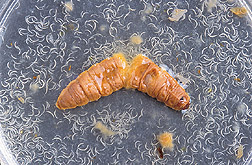This page has been archived and is being provided for reference purposes only. The page is no longer being updated, and therefore, links on the page may be invalid.
|
Read the magazine story to find out more. |
Insect Remains Are Better 'Suited' for Fight Against PestsBy Jim CoreMay 13, 2002 A team of Agricultural Research Service scientists has developed a patented formula that coats and holds fragile insect cadavers together. Why preserve dead bugs? Not for the cadavers, but for the nematodes inside them. These nematodes are beneficial because they kill pests but don't harm humans or the environment. Beneficial nematode offspring escape their deceased hosts when placed in orchards or greenhouse soils. The nematodes then protect crops such as citrus, pecans, cranberries, greenhouse ornamentals and mushrooms from soil-dwelling pests like citrus root and black vine weevils. The nematodes also pack another potent weapon against pests: bacteria that live inside them. Once the nematode infects an insect pest, the bacteria leave the nematode and they both, working together, kill the pest after about 48 hours. The nematodes and bacteria then feed off their host and reproduce inside it. The usual method of releasing nematodes into a desired environment is through a liquid spray solution, but this is often more expensive than chemical insecticides. The cadaver method allows many more nematodes to be reared in insects at a lower cost, according to David I. Shapiro-Ilan, a research entomologist at the Southeastern Fruit and Tree Nut Research Laboratory in Byron, Ga. A patented starch-and-clay coating was developed to protect the insect cadavers from deterioration. Shapiro-Ilan collaborated with Edwin E. Lewis, a professor of entomology at Virginia Polytechnic Institute and State University in Blacksburg, Va., and other ARS researchers to find a way to successfully formulate cadavers using sticking agents and powders. The coating makes it easier to store and handle the cadavers and also improves tolerance to environmental extremes. When the surface becomes moist, the coating degrades rapidly because it is made from environmentally friendly materials. H&T Alternative Controls, LLC, of Perry, Ga., recently signed a cooperative research and development agreement with ARS--the chief scientific research agency of the U.S. Department of Agriculture--to mass-rear nematodes and produce infected cadavers. More information can be found in the May 2002 issue of Agricultural Research magazine. |

